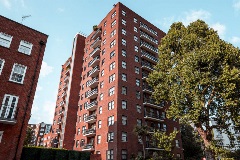
Jordana Lyons - City of Toronto Issues 2021 Open Door Program Call for Applications
by Jordana Lyons, Articling Student at Robins Appleby
On November 24, the City of Toronto (the “City”) issued its 2021 annual call for applications to its Open Door Affordable Rental Housing Program (the "Open Door Program").
About the Open Door Program
The City created the Open Door Program as part of its HousingTO 2020-2030 Action Plan (the “Action Plan”). The Open Door Program helps non-profit and private sector housing developers with costs of creating affordable housing by providing successful applicants with:
- City capital funding for affordable rental housing projects;
- Certain financial incentives to developers such as exemptions from development charges, parkland levies, planning/building permit fees and property taxes; and
- Expedited planning approval and review.
Housing organizations may apply to receive either or both of capital funding and incentives. Please note: where a project is a mixed-use development or only some of the units are affordable, contributions and incentives will only be provided for the portion of the development relating to the affordable units.
The 2021 Call for Applications
For the 2021 application year, the City has made up to 10 million dollars available in capital funding and there is no limit on the value of incentives that may be provided. Both non-profit and private sector housing developers who wish to build and operate affordable rental housing may apply to the Open Door Program by filling out the application package by February 24, 2022. The expected processing time is four months.
Eligible Projects
Organizations creating affordable rental housing are eligible to apply to the Open Door Program. “Affordable housing” is defined by the City as “new housing where the total monthly shelter cost (gross monthly rent, including heat, hydro and hot water, but excluding parking and internet/cable charges) is at or below Toronto’s average market rent (AMR) by unit type (number of bedrooms), as reported in the fall of each year by the Canada Mortgage and Housing Corporation (CMHC)”.[1]
The types of projects which are eligible for the Open Door Program include:
- New construction;
- Conversion of non-residential buildings to purpose-built rental housing;
- Addition of new affordable units or buildings to existing sites or buildings; and
- Certain social housing redevelopment.
Developments which provide affordable housing under Section 37 of the Planning Act, the Official Plan’s Large Sites Policy (Policy 3.2.1.9), or the Rental Replacement Policy (Policy 3.2.1.6) are eligible for the Open Door Program if the development provides affordable housing benefits beyond those already required (such as additional units, longer affordability periods or more affordable rents).
Housing projects which are not eligible include:
- Nursing and retirement homes;
- Shelters and crisis care facilities;
- Student housing; and
- Rental housing in a condominium building. [2]
The City particularly encourages applications that propose rental housing for priority tenant groups under the Action Plan (includes Black/Indigenous people, women, seniors, youth, people with disabilities, and people experiencing homelessness).[3] For the first time, in the 2021 call for applications, a minimum of 20% of the total available funding will be allocated to Indigenous housing projects.
Application Process
The application process is competitive and applicants must demonstrate that funding/incentives are necessary to support a viable and sustainable project. The information that must be submitted by the applicant includes:
- Details of the proposed project;
- Development qualifications;
- Management qualifications;
- Corporate financial viability;
- Building design;
- Development schedule;
- Capital and operating financial plans; and
- Community consultation plan.[4]
Each year the City sets certain program terms to be met by applicants. For the 2021 application, the terms include the following:
- The minimum period for which affordable rents must be provided is 40 years, including a five year phase-out period;
- Target minimum of 30% of residential gross floor area of a development must be set aside for affordable rental housing;
- Rent for affordable units must not be more than 100% Average Market Rent; and
- City benefits must be accepted for a minimum of 20% of the affordable units.[5]
Applications will be evaluated based on how a proposed project meets and exceeds the above terms. The City will also consider whether the project assists priority tenant groups as identified in the Action Plan. To be successful, proposals must score a minimum of 70% in the evaluation process. Successful applicants will meet with the City to determine next steps. Within 60 days after an application receives approval from City Council, the applicant will sign a Contribution Agreement with the City which will set out the details of the project and the contributions to be made by each party.[6] A sample Contribution Agreement can be found here.
Housing projects which are approved through the Open Door Program are required to follow the City’s processes for tenant selection, income verification and reporting.
Key dates for the 2021 call for applications are as follows:
- Tuesday, December 14, 2021 at 1:00pm: online information session
- Thursday, February 3, 2022: last day to submit written questions
- Tuesday, February 15, 2022: Final Addendum (if required)
- Thursday, February 24, 2022 at 12:00pm: deadline to submit applications
Further details about the Open Door Program, the 2021 call for applications and the application package can be found here.






